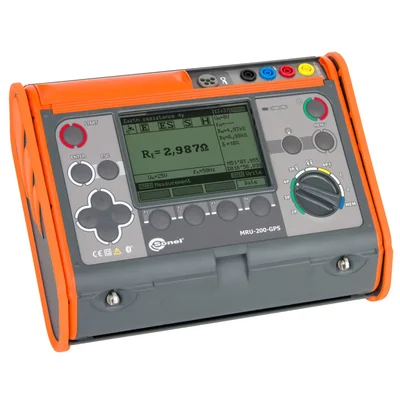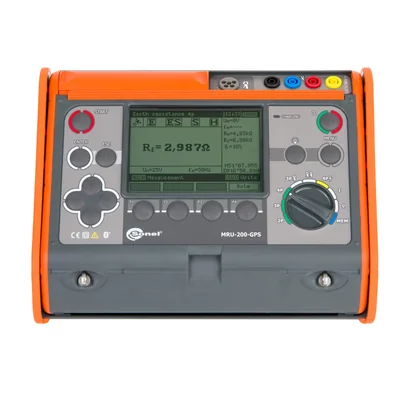Earth resistance and soil resistivity meter MRU-200-GPS WMPLMRU200GPS
 Na zamówienie
Na zamówienie
Opis produktu
The MRU-200-GPS meter (as the only one in the world) uses all known earth resistance measurement methods, which definitely distinguishes it from other devices. It has a built-in GPS receiver - saving the result with location coordinates.
Allows you to perform measurements of:
- earth resistance using auxiliary electrodes,
- earthing resistance with the use of auxiliary electrodes and clamps (for the measurement of multiple earthings),
- earthing resistance with the use of double clamps (for earthing measurements when the use of auxiliary electrodes is not possible),
- earthing using the impulse method (without the need to disconnect the measured earth electrodes),
- earth resistivity (Wenner method),
- current using clamps (e.g. leakage) and flexible clamps (coil Rogowski)
- fault currents,
- measurement of continuity of equipotential bonding and protective connections (meeting the requirements of PN-EN 60364 - 6-61:2000 point 6.12.2) with auto-zeroing function - current 200 mA .
Additionally:
- measurement of resistance of auxiliary electrodes RS and RH,
- measurement of interference voltage,
- measurement of the frequency of the interfering signal,
- measurement in the presence of interfering voltages in networks with the frequency of 16 2/3 Hz, 50 Hz, 60 Hz and 400 Hz (with automatic selection of the appropriate frequency of the measurement signal or manual selection),
- selection of the maximum measurement voltage (25 V and 50 V),
- entering the distance between the electrodes for resistivity in meters (m) and feet (ft),
- memory for 990 measurements (10 banks of 99 cells each),
- calibration of applied clamps,
- real time clock (RTC),
- data transmission to USB computer,
- battery status indication.
Measurement category: CAT IV 300V (CAT III 600V)
Dane techniczne
-
Level of securityIP54
Opis producenta
Multifunctional earthing and soil resistivity meter
The Sonel MRU-200-GPS earth resistance and soil resistivity meter allows the use of all known earth resistance measurement methods. This renders it an unrivalled measuring instrument in its category and definitely makes it stand out from other devices of its kind. Sonel MRU-200-GPS allows you to perform tests with the 3-pole and 4-wire method, using additional clamps (multiple earthing), as well as the two-clamp method and impulse method (earth impedance measurement).
The application of the two-core measurement method allows, under certain conditions, to perform earth resistance measurements without the use of auxiliary probes which are driven into the ground. The impact method, on the other hand, is used for diagnosing lightning protection earthing, but can also be used to measure extensive, multiple and connected earthing (including underground) without interfering with the circuit. With the use of the impact method it is possible to carry out measurements in accordance with EN 62305 - the need to measure earth impedance. It is worth noting that the instrument also has a built-in GPS receiver, which allows for recording the result along with the coordinates of the location. An additional function of the meter is the possibility of carrying out measurements of soil resistivity, continuity of protective and equalising connections and, with the use of clamps, also leakage or fault currents.
The high class of the device is confirmed by the excellent accuracy of the result it produces. The meter makes measurements in accordance with the EN 61557 standard starting from 0.100 Ω.
Measurement methods
- Impulse method – measurement of lightning protection systems with a measuring impulse ramp of 4/10 μs, 8/20 μs, 10/350 μs
- 3-pole and 4-wire method – measurement of earthing systems using auxiliary probes
- 3-pole method with clamp – measurement of earthing systems with multiple earth electrodes
- Two-clamp method – measurement of earthing system when the auxiliary probes cannot be used
- Earth resistivity – Wenner method
- Resistance of earth and compensatory conductors measured using current ≥200 mA with auto-zero function – meets the requirements of EN 61557-4
- Measurement of leakage current
Additional features
- Built-in GPS receiver – recording results with location coordinates
- Measurement of resistance of auxiliary electrodes RS and RH
- Measurement of interference voltage
- Measurement of interference frequency
- Measurement in the presence of interference voltage generated by power networks with frequency of 16 2/3 Hz, 50 Hz, 60 Hz, 400 Hz
- Selection of maximum measuring voltage (25 V and 50 V)
- Automatic calculation of soil resistivity in ohm-meters (Ωm) and ohm-feet (Ωft)
- Memory of 990 measurement results (10 banks of 99 cells each)
- Calibration of clamp used
- Real time clock (RTC)
- Data transmission to the computer and mobile devices
- Battery indication
Application
MRU-200-GPS meter was created for the most difficult working conditions. It generates a measuring current exceeding 200 mA, which provides effective measurements of grounding of energy objects such as transformer stations and power stations.
Thanks to the methods using clamps, it is not necessary to disconnect the control connectors, which is sometimes a very tedious operation. This plays a special role when performing works on objects exposed to weather conditions, where the connecting elements are sometimes corroded or tarnished.
The graphical user interface provides clear readings and explicit messages. This translates into quick, trouble-free service.
Impulse method
MRU-200-GPS may be used to test earthing of lightning protection systems, as this meter is able to simulate the conditions occurring during a lightning strike – it generates current with a standardized pulse leading edge and a time to half-peak. Available impulse ramps include 4/10 μs, 8/20 μs, 10/350 μs.
Compatible with ERP-1 adapter
ERP-1 adapter allows user to test earthing systems using flexible clamps. This is particularly useful, e.g. in case of lattice towers – there is no need to switch off the line or disconnect control connectors. Proprietary algorithm allows user to check the current direction in the individual measurements and facilitates damage detections, e.g. corroded steel strip (hoop).
Capabilities
The measuring methods available in the device allow for comprehensive control of working and protective grounding. The calibration function of the test leads eliminates the influence of their resistance on the result. However, this is just the beginning.
- The four-lead method provides very accurate measurement of the expected small values of resistance – eliminates the resistance of the test leads connecting the meter to grounding.
- Measurement of the continuity of protective connections and equipotential bondings with a current exceeding 200 mA meets the requirements of EN 61557-4 standard.
- Before performing the measurement, the meter checks whether the tested object is a subject to excessive interference voltage, which may indicate additional problems.
Memory and results
The results can be saved to the device’s memory. It is divided into 10 banks of 99 cells, each corresponding to one measurement. These results can be easily transferred to the Sonel Reader software for archiving or subsequent analysis and research.
Bluetooth wireless interface may be used to transfer measurement results to PC software or to a mobile phone with dedicated app – Sonel MRU Mobile. This provides not only data archiving function, but further data transfer – directly from the measurement site via an e-mail.
Dane producenta
-
ProducentSONEL S.A.
-
Adres58-100 Świdnica Wokulskiego 11 Polska
-
Email














